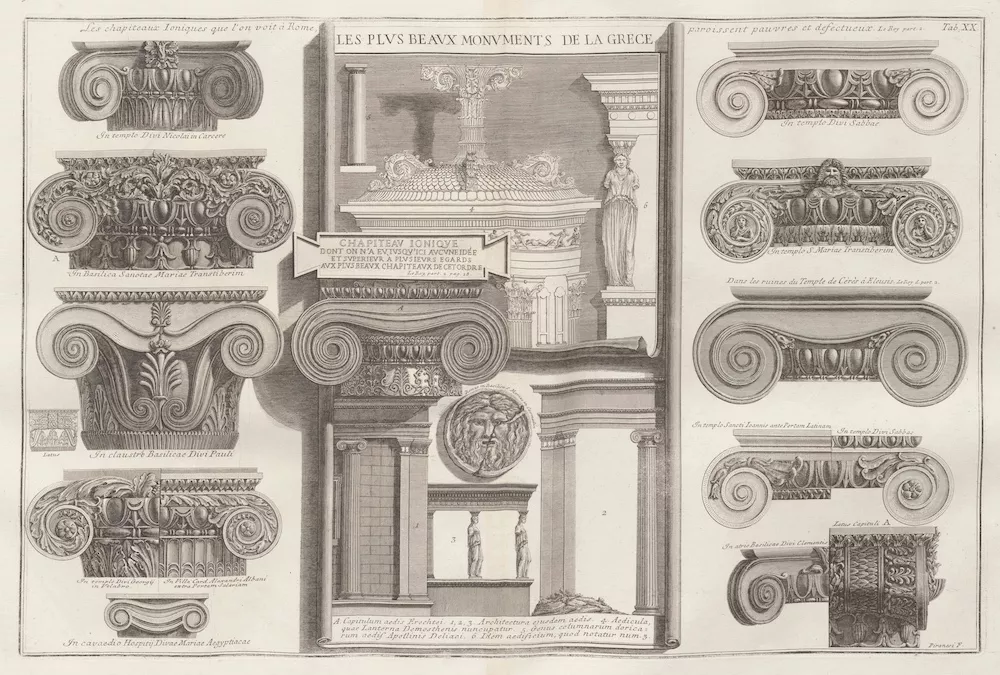Creation Date
1761
Height
40
Width
59.8
Medium
Genre
Description
This composite image assembles Ionic column capitals from various buildings in Rome in order to argue for the superiority and the magnificence of Roman as opposed to Greek architecture. His argument relies on fragments of texts and buildings. Visual citations and architectural details serve as his bibliographical and graphical evidence.
Piranesi used innovative methods of graphic display to express his disagreements with other writers on art and architecture. This layered image is among Piranesi’s most polemical. In 1758, French architectural historian David Le Roy’s Les Ruines des Plus Beaux Monuments de la Grèce [The Ruins of the Most Beautiful Monuments of Greece] asserted the superiority of Greek architecture. In a passage that Piranesi singles out, somewhat inaccurately, he claims that “the Ionic capitals one finds in Rome are stylistically poor and defective.” Along the top margin of this image, Piranesi reproduces this claim; by providing visually striking examples of Roman Ionic capitals, he refutes it. Piranesi visually cites other examples from Le Roy in the scroll that appears to unroll in the image’s central panel. These features of Greek architecture, including caryatids and columns, are “most beautiful” according to Le Roy, but in Piranesi’s altered rendition of them, they appear flat and dull. Together in the central panel with Le Roy’s details of Greek architecture, Piranesi includes the Roman mouth of truth, which, according to legend, bites the hand off of anyone who tells a lie. The somewhat humorous but no less pointed implication is that Le Roy is simply not telling the truth.
Piranesi then presents his own evidence: numerous Ionic capitals found throughout Rome—by depicting them. in vivid contrast, identifies them individually by their location, and even shows one from two angles, in the second example from the top left and the right half of the bottom example on the right of the image. Other capitals are, like the bottom example on the right, divided in half and shown abutting another. (The middle example on the right is Greek, taken from Le Roy.) Piranesi’s chosen Roman capitals are varied in design and relief, with vivid chiaroscuro lending their scrolled volutes almost three-dimensional effects.
His citation of Le Roy’s claim and the Greek capital on the right of the image both include textual citations that point to the section in Le Roy’s treatise from which they’re taken. The paper scroll includes curling edges, in an echo of the scrolled volutes that are characteristic of Ionic capitals. But the curling paper is also a reminder of and contrast with the medium he and Le Roy use: the printed page within the bound book. With these details, Piranesi creates an emphatically bookish image to stake his claim—that Rome is in fact full of magnificent examples of Ionic capitals—through conspicuous verbal and visual citation.
Associated Persons
Publisher
Firmin Didot
Collection
Accession Number
NE 662.P5 A2 vol. 7
Additional Information
Printing Context
The versions of the etchings included in this exhibit come from the Didot edition of Piranesi’s Opere [Works] published in Paris between 1835 and 1839. They thus of course represent the final state and include any reworking for printings that followed the plates’ original pressings. The journey of Giambattista Piranesi’s original copper plates from Rome to Paris is directly tied to international military and state affairs. In 1798 during the upheaval following the French Revolution, Neapolitan troops invaded Rome. The Piranesi print shop and museum was ransacked, and all of the copper plates stolen. Francesco appealed to French officials to have the plates returned; after an interception by an English warship, the plates were reunited with Francesco and his brother Pietro, who had both fled to Paris. After Francesco’s death in 1810 and many potential and actual sales, the plates were eventually acquired by the Didot press. A dynastic printing house for two centuries, the Didot family were major innovators in printing and recipients of international awards for typography.
Provenance
This digital image is from a complete 29-volume set of Piranesi’s posthumous Opere (1835-1839) held by the Irvin Department of Rare Books and Special Collections, University Libraries, at the University of South Carolina. It was scanned in the Digital Collections Department. The set was likely acquired directly from the publisher, and the cover of each volume bears the imprint of the name of the university up through 1866: South Carolina College.

